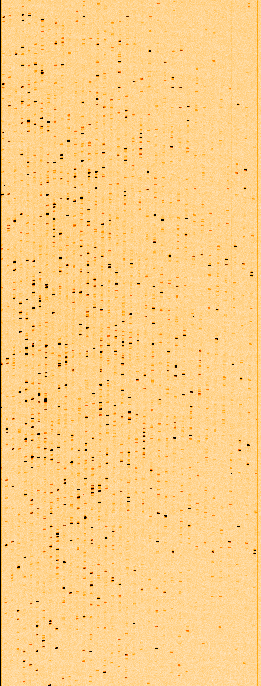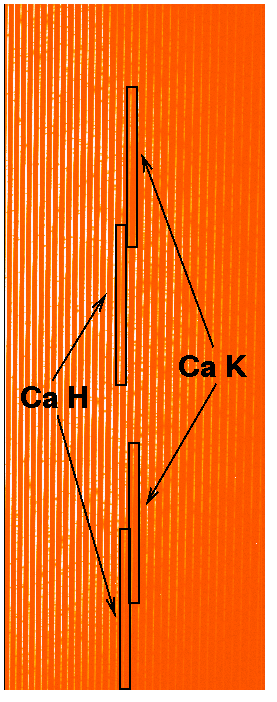
The Anglo-Australian Planet Search (AAPS) is a long-term program being carried out on the 3.9m Anglo-Australian Telescope (AAT) to search for giant planets around more than 240 nearby Solar-type stars with V<8. We use the "Doppler wobble" technique to search for these otherwise invisible extra-solar planets, and achieve the highest long-term precision demonstrated by any Southern Hemisphere planet search.
CaHK Observing Notes for AAPS
Setup
The UCLES camera cannot cover the CaHK lines and the full iodine absorption window simultaneously. So for standard AAPS observing, we use a setup that covers the iodine region and the Ca infrared triplet simultaneously. CaHK observing runs have to be done in a dedicated set-up.
NB: these notes describe the setup for Ca HK observing with the old VAX-based observing system. With the AAO2 ODC system you want the same set-up, but managed with a different interface. Any AAPS observer who's used the AAO2 ODC system should be able to work out how to get this going, using the following notes as a guide.
The setup procedure for Ca HK observations is very easy. Essentially it is the same as that for regular AAPS observing, except that the wavelength setting is different and the iodine cell is removed. The good news is that the precise wavelength setting is not at all critical, so you can use the UCLES wavelength setting defaults with some confidence that the required Ca HK lines will appear in your spectrum at the right place.
•CCD setup is the same as for AAPS (WINDOW EEV_PLANET_BX2)
•Remove Iodine cell.
•UCLES set up is almost the same as for AAPS, because we do not need to worry hugely about focus (if you've focussed for AAPS observing that will do), and we do not need to worry hugely about the orders being straight (I assume they're curved anyway in the reduction) or being central (as long as Ca HK is on the detector, that's all that matters). We do use the beam rotator though, so we don't lose UV flux off the slit. So all you need to do is
Ucles: CENTRE PEAK 3950
ECHELLE - Which grating? (31 or 79) /'79'/ >31
WAVELENGTH - Wavelength? /...../ > 3950
OBSFILE File to start results /'setup'/ >
CONFIG
sw 1 arcsec
sl 5.5 arcsec (for flats)
sl 4.5 arcsec (for data)
br in (insert the beam rotator)
vertical (make BR keep slit vertical on sky)
The central order should end up being order 144 (+-1), and the central wavelength should be close to 3950A.
If you are changing from the AAPS configuration and want to go back to it afterwards, you should write down the ET,EG,SA, etc so you can go directly back to that configuration.
It will be blindingly obvious if you have the set-up correct when you take your first observation. There should be four big fat absorption lines (ie Ca H and Ca K each of which is reproduced twice on the spectrograph's detector) staring you in the face.
Once you have your first observation, check that the UV light where the CaHK lines are is not running off the end of the slit. You may need to guide with the star slightly towards the red end of the slit on the TV in order to ensure you don't lose UV photons off the blue end of the slit. Alternatively, put a B filter on the guide camera before you start.
CaHK Setup ARC (left) and CaHK Setup star (right)


Observing
Observing is very simple. The exposure times for Ca HK are short. A S/N per pixel of ~50 is more than adequate in the Ca HK region. The UCLES S/N calculator indicates the following S/N and exposure times for the continuum regions in 1.5" seeing - experience shows them to be reasonable.
-
V=6 Exp=60 S/N=144
-
V=7 Exp=60 S/N=90
-
V=8 Exp=60 S/N=56
-
V=9 Exp=120 S/N=50
There is not much point in exposing for less than about 60s, given the detector's read-time, and the overheads in slewing. In bad seeing (>2", and this is a good bad seeing program) exposures should be increased to ~120s to V=8 and ~240s to V=9.
Calibration
Acquire a single ThAr arc at the start or end of the observing on each night, and before/after you fill the dewar if you do that during CaHK observing.
Acquire wideflats in the same way as is done for the AAPS (ie increase slit length as above, and take a bunch of Quartz spectra).
It is important to also acquire calibration stars while doing this observing program. As usual ~5-10% of the time spent observing targets should be spent on calibrations. You should also try to cover a range of R'HK values (Inactive, Moderate and Active) and a range of spectral types in each activity group. Finally, you should ALSO take a single flux standard star with the 1" wide slit to take out the spectrograph response function. The stars mu Col (HR1996), zi 2 Cet (HR718), eta Hyi (HR3454), theta Cra (HR4468) and zeta Peg (HR8634) from the HST Standards list are bright enough and hot enough to be good for this.
Here is a list from which you can select activity standard targets.
R'HK Calibration stars
You can get an excel spreadsheet or a postscript file to print out with this information.

Contact Information
AAT Control Room +61 48 42 6279
AAT FAX +61 68 84 2298
AAT Co-ordinates
-
• Geodetic coordinates:
-
• Longitude = 149:03:57.91 = 9h56m15.861 East
-
•Lattitude = 31:16:37.34 South
-
•Altitude = 1164 m

Page last updated: 9 July 2007.
